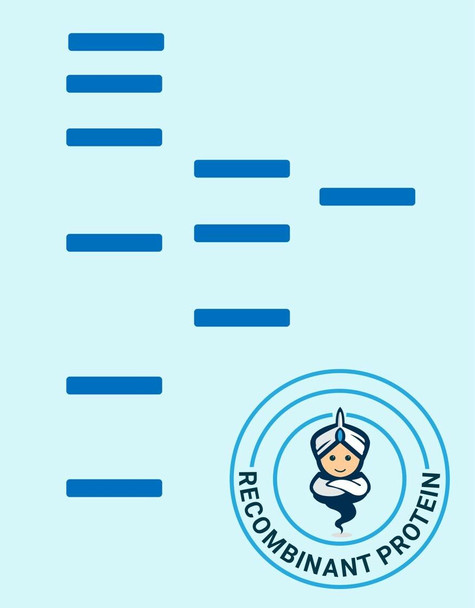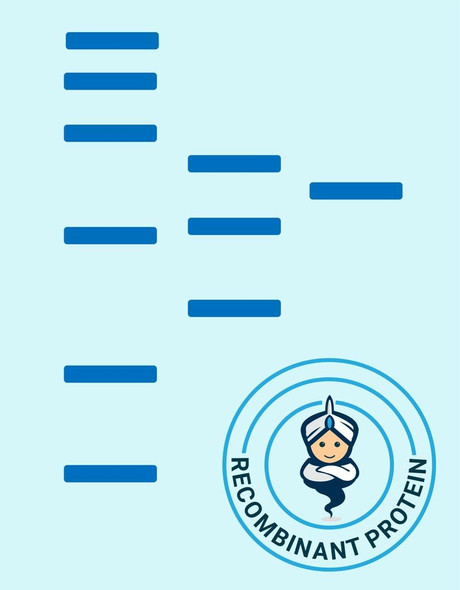Description
| Product Name: | Human PSMB1 Recombinant Protein |
| Product Code: | RPPB2204 |
| Size: | 10µg |
| Species: | Human |
| Target: | PSMB1 |
| Synonyms: | HC5, PSC5, PMSB1, FLJ25321, KIAA1838, PSMB1, Proteasome subunit beta type-1, Proteasome component C5, Macropain subunit C5, Multicatalytic endopeptidase complex subunit C5, Proteasome gamma chain. |
| Source: | Escherichia Coli |
| Physical Appearance: | Sterile Filtered clear colorless solution. |
| Formulation: | The PSMB1 solution contains 20mM Tris-HCl pH-8, 1mM DTT and 10% glycerol. |
| Stability: | Store at 4°C if entire vial will be used within 2-4 weeks. Store, frozen at -20°C for longer periods of time. For long term storage it is recommended to add a carrier protein (0.1% HSA or BSA).Avoid multiple freeze-thaw cycles. |
| Purity: | Greater than 95.0% as determined by SDS-PAGE. |
| Amino Acid Sequence: | MRGSHHHHHH GMASMTGGQQ MGRDLYDDDD KDRWGSHMFS PYVFNGGTIL AIAGEDFAIV ASDTRLSEGF SIHTRDSPKC YKLTDKTVIG CSGFHGDCLT LTKIIEARLK MYKHSNNKAM TTGAIAAMLS TILYSRRFFP YYVYNIIGGL DEEGKGAVYS FDPVGSYQRD SFKAGGSASA MLQPLLDNQV GFKNMQNVEH VPLSLDRAMR LVKDVFISAA ERDVYTGDAL RICIVTKEGI REETVSLRKD |
PSMB1 is part of the proteasome B-type family, also identified as the T1B family, that is a 20S core beta subunit. PSMB1 is tightly linked to the TBP (TATA-binding protein) gene in human and in mouse, and is transcribed in the opposite orientation in both species.The main function of PSMB1 is its degradation activity of unnecessary or damaged proteins by proteolysis. PSMB1 is a multicatalytic proteinase complex which is characterized by its ability to cleave peptides with arg, phe, tyr, leu, and glu adjacent to the leaving group at neutral or slightly basic ph. the proteasome has an atp-dependent proteolytic activity.
PSMB1 Human Recombinant fused to a 37 amino acid His Tag at N-terminal produced in E.Coli is a single, non-glycosylated, polypeptide chain containing 250 amino acids (30-241) and having a molecular mass of 27.7 kDa. The PSMB1 is purified by proprietary chromatographic techniques.
| UniProt Protein Function: | PSMB1: a proteasomal protein of the T1B peptidase family. The proteasome is a multicatalytic proteinase complex which is characterized by its ability to cleave peptides with Arg, Phe, Tyr, Leu, and Glu adjacent to the leaving group at neutral or slightly basic pH. Proteasomes are distributed throughout eukaryotic cells at a high concentration and cleave peptides in an ATP/ubiquitin-dependent process in a non-lysosomal pathway. |
| UniProt Protein Details: | Protein type:Proteasome complex; Protease; EC 3.4.25.1; Cell cycle regulation Chromosomal Location of Human Ortholog: 6q27 Cellular Component: cytosol; nucleoplasm; nucleus; proteasome complex; proteasome core complex Molecular Function:protein binding Biological Process: anaphase-promoting complex-dependent proteasomal ubiquitin-dependent protein catabolic process; antigen processing and presentation of exogenous peptide antigen via MHC class I, TAP-dependent; MAPKKK cascade; negative regulation of ubiquitin-protein ligase activity during mitotic cell cycle; positive regulation of ubiquitin-protein ligase activity during mitotic cell cycle; proteasomal ubiquitin-dependent protein catabolic process; protein polyubiquitination; regulation of amino acid metabolic process; regulation of mRNA stability; stimulatory C-type lectin receptor signaling pathway; T cell receptor signaling pathway; tumor necrosis factor-mediated signaling pathway; Wnt receptor signaling pathway, planar cell polarity pathway |
| NCBI Summary: | The proteasome is a multicatalytic proteinase complex with a highly ordered ring-shaped 20S core structure. The core structure is composed of 4 rings of 28 non-identical subunits; 2 rings are composed of 7 alpha subunits and 2 rings are composed of 7 beta subunits. Proteasomes are distributed throughout eukaryotic cells at a high concentration and cleave peptides in an ATP/ubiquitin-dependent process in a non-lysosomal pathway. An essential function of a modified proteasome, the immunoproteasome, is the processing of class I MHC peptides. This gene encodes a member of the proteasome B-type family, also known as the T1B family, that is a 20S core beta subunit. This gene is tightly linked to the TBP (TATA-binding protein) gene in human and in mouse, and is transcribed in the opposite orientation in both species. [provided by RefSeq, Jul 2008] |
| UniProt Code: | P20618 |
| NCBI GenInfo Identifier: | 130853 |
| NCBI Gene ID: | 5689 |
| NCBI Accession: | P20618.2 |
| UniProt Secondary Accession: | P20618,Q9BWA8, B5BU76, |
| UniProt Related Accession: | P20618 |
| Molecular Weight: | 26,489 Da |
| NCBI Full Name: | Proteasome subunit beta type-1 |
| NCBI Synonym Full Names: | proteasome subunit beta 1 |
| NCBI Official Symbol: | PSMB1�� |
| NCBI Official Synonym Symbols: | HC5; PSC5; PMSB1�� |
| NCBI Protein Information: | proteasome subunit beta type-1 |
| UniProt Protein Name: | Proteasome subunit beta type-1 |
| UniProt Synonym Protein Names: | Macropain subunit C5; Multicatalytic endopeptidase complex subunit C5; Proteasome component C5; Proteasome gamma chain |
| Protein Family: | Proteasome |
| UniProt Gene Name: | PSMB1�� |
| UniProt Entry Name: | PSB1_HUMAN |








